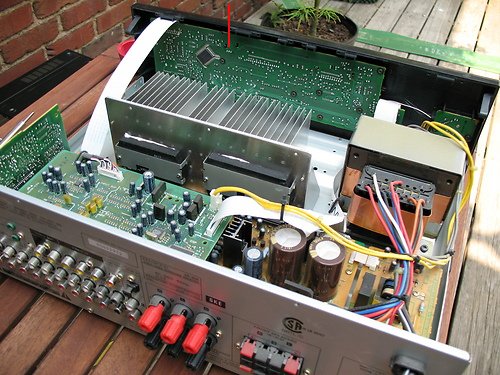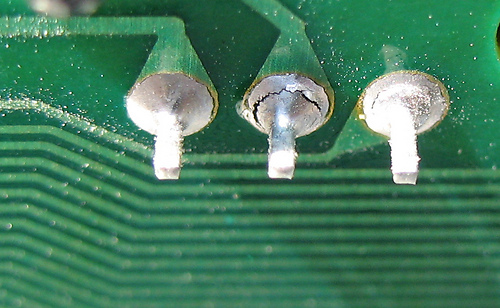Remotes Blog
Dec 16, 2020
Q) Why is my Kenwood remote not working? I JUST BOUGHT IT.
Credit to Tom Moertel for writing this article, the original can be found HERE.
A)
The Kenwood audio-video receiver that forms the core of my home theater system stopped responding to its remote control. As I discovered shortly thereafter, having to leave the couch to fiddle with knobs degrades the “home theater experience.” Clearly, something had to be done.
I knew the receiver was the culprit because the remote control worked fine with other components of my system. I figured the IR sensor had gone bad and did a little Googling for “Kenwood” and “IR sensor” and “problem”. The results revealed that many other Kenwood customers had the same problem.
The cause of the problem, I learned, was that the solder joints which connect the IR sensor’s leads to the display board eventually fail because of thermal expansion. That explanation seemed to account for what I was observing, so I cracked the case in search of visual confirmation.
First, I found the joints where the IR sensor was connected to the circuit board. The vertical red line shows where I found them:

Then I examined the joints closely. Sure enough, at least one had completely failed:

The problem confirmed, I moved to the solution phase of the project. With my soldering iron, I touched-up the joints:

It wasn’t my best work, but it did the job.
Now my receiver is back on speaking terms with its remote control, and I have returned to the modern world. Life is good
Feb 18, 2019
Q) Magnavox 20MS2331/17-How to get the CC or Menu off the screen.
A) The owner's manual says to use the Status/Exit button to remove the CC or Menu from the screen when you are through making your changes.
[email protected]
Jan 24, 2019
Q) Remote for Sony Stereo System SSRG444
A) Sony SS-RG444 is the model of the Speakers. The Receiver is HCD-GX450. The
remote is NLA (No Longer Available), but there is a replacement remote that has
all the features of the OEM remote. It is $29.90 + shipping and can be found
https://www.remotes.com/SearchResults.asp?Search=hcdgx450
[email protected]
Jan 15, 2019
Q) ITV ILT-M4205FHD needs a new remote control.
A) ITV no longer has replacement remotes for this model. I recommend getting a
universal remote control that has AUTO SCAN or SEARCH mode. The remote
systematically sends each code it contains, one at a time, until the TV
responds. Here’s a
universal
remote control
with Auto Scan on Amazon.com
[email protected]
Jan 7, 2019
Q) V-Zon TV2200
A) V-Zon is part of Coby. Matilyn needs a remote for a Coby V-Zon (VZon) TV2200
television. We have no OEM remotes and no replacement remotes for this model.
https://cobyusa.com/products/universal-remoteb
shows a universal remote control model CRC-02 that may work. They don’t sell it
on that site, but I did find a link to Walmart that sells it.
https://www.walmart.com/ip/Coby-CRC-02-8-in-1-Universal-Remote-1-ea/48430859
If you have a V-Zon TV and need a remote control, try using the Coby codes listed
on many universals.
[email protected]
Jan 7, 2019
Q) Sharp RRMCG1231CESA
A) The Sharp remote for these models, RRMCG1231CESA, G1231CESA, 13HM60, 19HM60,
19TH30, 20HM60S, 25HM60, RRMCG1124CESA, G1124CESA, 13GM60, 13TG30, 19GM60,
19GM120, 20GM60, 25GM60, now substitute to the Redi Remote RTRRMCG1231CESA. It
does not need any programming and will work right out of the package. Here is a
link to the product page.
https://www.remotes.com/sharp-p/sharp%20rtrrmcg1231cesa.htm
[email protected]
Jan 7, 2019
Q) Remote for Cambridge Audio Azur 840E
A) We do not have any OEM or replacement remote controls for this model, but we
do have many replacement remotes for Cambridge Audio.
https://www.remotes.com/SearchResults.asp?Search=cambridge+audio
[email protected]
What is the range of
a remote control?
Remotes are convenient tools that make our lives a lot simpler, but they have
their limitations. The limits often come down to the type of signal a remote
sends. We’ll go over the differences and the limits in this article. After
reading this, you can be confident of the range and limitations of the remotes
you use every day, which can help you use your electronics to their potential
and help with troubleshooting remote issues.
Infrared
The vast majority of remotes for consumer electronics used today (2018) are
infrared remotes. Invented in 1980 by ViewStar, infrared became the dominant kind
of remote because it has a much larger range of functions that can be programmed
in the remote than previous technologies. Many manufacturers use distinct
frequencies of infrared light and unique patterns of light for each of the
functions a remote can do. <a href=”https://science.nasa.gov/ems/07_infraredwaves:>Infrared</a>
signals are light waves that are past the visible spectrum we can see. So, you
won’t be able to see the signal the remote is sending with your naked eyes, but
they can be detected by most digital cameras.
The limitation of infrared signals is the dispersion or blocking of the light.
Most infrared remote signals will be too weak to reach past about 30 feet, or
30 degrees to the right or the left of the sensor in the unit the remote
controls, but an object placed in front of the sensor will keep a remote from
working at all. Since infrared is limited by line-of-site and dispersion beyond
a very short distance, it only makes sense that they are now starting to lose
ground in popularity to the latest type of remote which is the next category.
Bluetooth
Second in the number of remotes in use today for consumer electronics,
Bluetooth is quickly being integrated in all sorts of electronics because of
its versatility. The Dutch company Ericcson invented Bluetooth in 1994 to
wirelessly transfer data over short distances. Since then the standard has been
used for all sorts of electronics including, wireless speakers, phones, stereo
receivers, car entertainment systems, and many others. Bluetooth uses radio to
establish two-way communication between the remote and the device it controls
through an exclusive connection between the two called pairing. In the case of
a TV that has a Bluetooth remote, this kind of connection allows for much more
complex data transfer between the remote and the TV than with a traditional
infrared remote. If you’ve seen commercials where people are talking into the
remote to find TV shows or movies they want to see, they are using a Bluetooth connection.
Like all electronics that send energy signals, there is a limitation to the
range because the signal attenuates or dissipates over distance. The first
version of Bluetooth used a very low voltage transmitter which only reached 30
feet. However, Bluetooth 2.0 has improved the performance drastically both in
the quality of data transfer and the distance the signal will reach. With 2.0,
a signal is strong enough to transmit up to 100 feet away. One advantage of a radio
signals is that it will go through wood walls and bounce around corners. Many
Bluetooth devices do not need to have line of sight to the other Bluetooth
device they are connected to. With Bluetooth, some manufacturers are even
creating Apps for smartphones to use the technology and allow people to use
their phone as a remote control.
Ultrasonic
Tiny hammers? Zenith invented a miniature piano that fits in the palm of your
hand and used aluminum rods and small hammers to strike the rods which produces
a soundwave that is too high for our ears to pick up. That is basically, what
an ultrasonic remote is. Usually consisting of 4-6 rods early on, the
ultrasonic remote was limited in what functions it could control, but it was a
consistent performer and was the standard in Television remotes for about 20
years. The effective range of an ultrasonic remote depends on the
sophistication and sensitivity of the sensor. Current sensors can detect an
ultrasonic signal from about 20 meters or 70 feet away. However, attenuation of
the signal (reduction of the strength of the signal over distance) varies. The
higher the frequency, the shorter the distance the signal will travel because
the signal doesn’t have enough strength to travel very far.
Ultrasonic remote controls for TVs only worked within about 20 feet of the
television because of the technology of the time, and the amplitude of the
signal was not boosted electronically.
Summary:
Below is a chart that shows the type of signals used by each type of remote
covered in this article and also the limitations of each technology.
|
Remote
|
Invented
|
Signal
|
Distance
|
Limitation
|
|
Ultrasonic
|
1956
|
Sound
|
20 feet, not limited by direction.
|
Number of commands
|
|
Infrared
|
1980
|
Light
|
30 feet, limited to line of site.
|
One-way communication
|
|
Bluetooth
|
1994
|
Radio
|
100 feet, not limited by direction or line of site.
|
Interference
|
For more information on the history of remote controls in consumer electronics,
please see our article on the History of Remotes. (Internal link to first
article)
For more information on the technology of signals used for communications I
recommend this as a good article:
https://en.wikipedia.org/wiki/Frequency-hopping_spread_spectrum
For more information on Bluetooth
signal technology, I recommend Bluetooth’s website:
https://www.bluetooth.com/bluetooth-technology